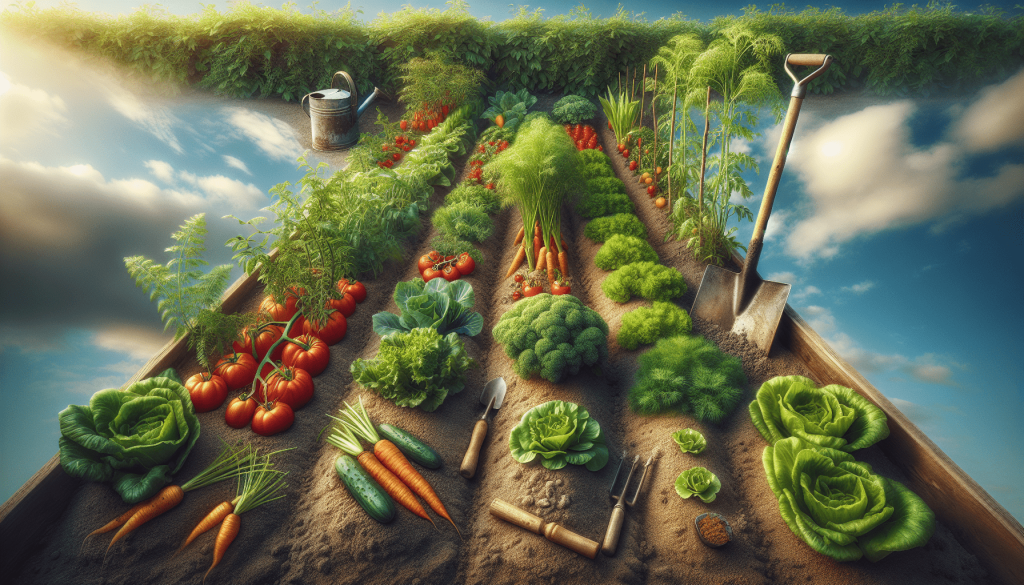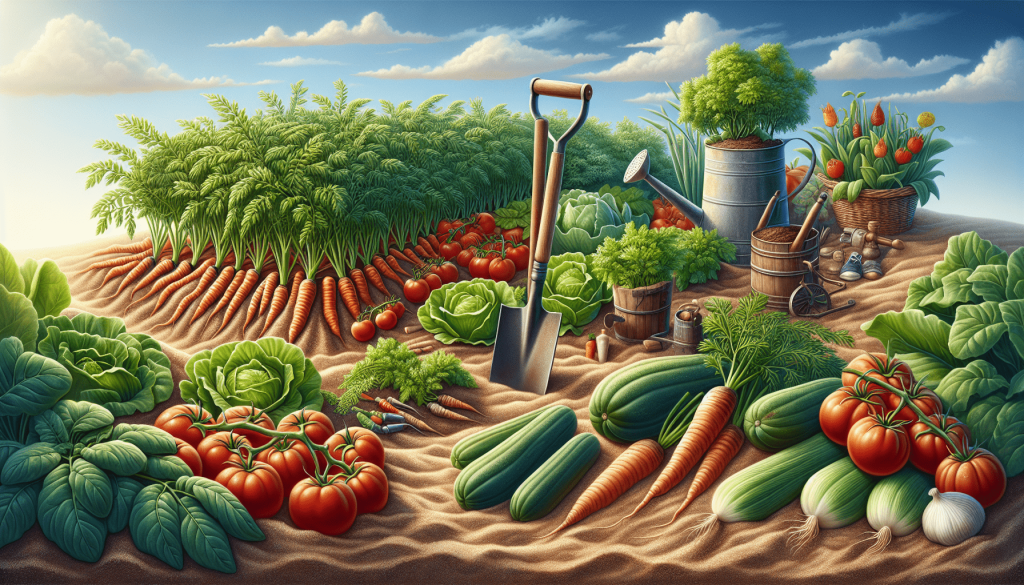This post may contain affiliate links. As an Amazon Associate, we may earn commissions from qualifying purchases.
Have you ever wondered how you can successfully grow vegetables in sandy soil? Growing vegetables in sandy soil can be a bit of a challenge, but it’s far from impossible. You might think of sandy soil as that fickle relative who never seems to hold onto anything, not even a dollar from grandma. But with the right techniques, you can transform this finicky medium into a flourishing garden. Let’s unravel the secrets together, shall we?
Understanding Sandy Soil
Before diving into techniques, it’s essential to understand what sandy soil is and its characteristics. Sandy soil is typically light, gritty, and doesn’t hold onto water well. Think of it as the soil that refuses to play the long game—it prefers instant gratification, letting water and nutrients slip by without so much as a backward glance.
Characteristics of Sandy Soil
Let’s start with the basics. Sandy soil is made up of larger particles, which provide more air space and better drainage but lack the ability to retain water and nutrients. Due to these characteristics, sandy soil heats up quickly in the spring and cools down fast in the fall. This means you’ll need to pay close attention to temperature and moisture levels to make sure your plants are happy.
Pros and Cons of Sandy Soil
To better understand sandy soil, let’s break it down into pros and cons:
| Pros | Cons |
|---|---|
| Drains well, reducing root rot | Poor nutrient retention |
| Easy to work with | Low water retention |
| Heats up quickly in spring | Prone to drying out |
| Good for root vegetables | Nutrients can leach away easily |
See, it’s not all bad news! Knowing these pros and cons will help you figure out the best approach to take when growing your vegetable garden.
Amending Sandy Soil
Amending sandy soil isn’t just a one-time fix; it’s more of a lifestyle choice—like deciding to eat your greens every day rather than just during a health kick in January. With regular attention and care, sandy soil can become a rich, loamy oasis for your veggies.
Adding Organic Matter
One of the most effective treatments for sandy soil is adding organic matter. Think of organic matter as the multivitamin your soil desperately needs. It helps improve water retention, nutrient retention, and even soil structure.
Types of Organic Matter to Use
There’s a buffet of options to choose from, such as:
- Compost: Rich in nutrients and easy to make at home.
- Manure: Best when aged or composted to avoid burning plants.
- Leaf Mold: Decomposed leaves that improve soil structure.
- Peat Moss: Improves water retention but can be acidic, so use it wisely.
When adding organic matter, aim for a couple of inches mixed thoroughly into the top six to eight inches of soil. This isn’t a one-and-done deal; you’ll need to keep at it, but it’s worth the effort.
Mulching
Mulching is another key technique. Imagine mulch as a cozy blanket for your plants—it helps maintain moisture, regulate soil temperature, and even adds nutrients as it breaks down.
Types of Mulch to Consider
There are various types of mulch, each with its perks:
- Organic Mulch: Such as straw, wood chips, or grass clippings.
- Inorganic Mulch: Such as gravel or plastic sheeting.
Your best bet is often organic mulch, as it can break down and further enrich your soil.

Water Management
Watering sandy soil can feel like trying to fill a bottomless pit. But worry not! There are strategies to manage water effectively.
Frequent, Light Watering
Frequent, light watering is usually the best approach. Since sandy soil drains quickly, it’s better to water more often but in smaller amounts. Plants don’t like to be waterlogged, but they also don’t want to go on a desert trek.
Drip Irrigation
For a more hands-off approach, consider drip irrigation. This system delivers water directly to the plant’s roots, reducing waste and ensuring that your veggies get the hydration they crave. Plus, it feels like you’ve got a little garden butler, always ready to cater to the plants’ needs.
Nutrient Management
Due to its poor nutrient retention, sandy soil is like that friend who needs constant reminders and pep talks—always in need of a little extra help to stay on track.
Regular Fertilization
With sandy soil, you’ll want to fertilize more frequently but in smaller amounts. Slow-release fertilizers are a great option as they give your plants a steady supply of nutrients over time.
Types of Fertilizers
Here’s a quick glance at your options:
| Type | Benefits |
|---|---|
| Organic fertilizers | Longer-lasting, improves soil health |
| Synthetic fertilizers | Immediate nutrient availability |
Choose your fertilizers based on what suits your garden the best. For instance, fish emulsion and kelp meal are great organic options that offer a slow nutrient release.
Soil Testing
Testing your soil can provide a roadmap of what nutrients are lacking. Think of it as your garden’s annual check-up. Understanding your soil’s specific needs allows you to address deficiencies more precisely.

Plant Selection
Choosing the right vegetables to grow in sandy soil can make your gardening journey a lot smoother. Some plants are more forgiving and actually thrive in this well-draining medium.
Best Vegetables for Sandy Soil
Some vegetables that do well in sandy soil are:
- Carrots
- Radishes
- Potatoes
- Lettuce
- Beans
These veggies usually have relatively shallow roots, making them better suited for sandy environments.
Companion Planting
Companion planting pairs certain plants together to enhance growth and repel pests. It’s like setting your plants up on a blind date but without the awkward small talk. Carrots grow well next to onions, and beans can benefit from the company of corn or squash.
Crop Rotation
Think of crop rotation as giving your soil a well-deserved vacation. By planting different crops each season, you help maintain soil health and reduce pest issues.
Benefits of Crop Rotation
Here are some advantages of practicing crop rotation:
- Nutrient Balance: Different plants use different nutrients.
- Pest Control: Reduces the buildup of pests and diseases.
- Soil Structure: Improves overall soil health.
Being mindful of crop rotation can lead to more successful harvests and healthier soil over time.
Pests and Diseases Management
Pests and diseases can be the uninvited guests at your garden party. While sandy soil tends to have fewer fungal issues due to its drainage capabilities, it’s still susceptible to other problems.
Biological Control
Biological control involves using natural predators to keep pests at bay. Ladybugs, for instance, are fantastic at munching away aphids.
Organic Pesticides
If you’re wary of chemicals, organic pesticides can be a great alternative. Neem oil and insecticidal soap are examples that can help manage your garden’s unwanted visitors.
Hand Picking
For smaller gardens, sometimes the best method is just good old-fashioned hand-picking. It’s therapeutic, and it ensures you’re getting up close and personal with your plants.
Seasonal Adjustments
Different seasons bring different challenges, and sandy soil is no exception. Knowing how to adjust your techniques with the changing seasons can keep your garden thriving year-round.
Spring and Summer
In spring and summer, the focus is on planting and consistent care.
- Check soil temperature: Ensure it’s warm enough for planting.
- Regular watering: Hotter months call for more frequent watering.
- Mulching: Helps retain moisture as temperatures rise.
Fall and Winter
Fall and winter are your downtime but not your sleep time.
- Cover crops: Planting cover crops like clover can improve soil quality.
- Mulch for insulation: Keeps roots warm.
- Less frequent watering: Plants need less hydration during these cooler months.
Conclusion
Growing vegetables in sandy soil might initially seem like a Herculean task, but remember that sandy soil has its fair share of advantages. With some consistent care and strategic planning, you’ll find that your garden can yield bountiful harvests.
Key Takeaways
Here’s a quick recap of the techniques to keep in mind:
- Amend with organic matter: Improves water and nutrient retention.
- Mulch regularly: Helps maintain moisture and soil temperature.
- Frequent light watering: Prevents dryness.
- Regular fertilization: Keeps nutrient levels stable.
- Choose suitable vegetables: Opt for those that thrive in sandy conditions.
- Practice crop rotation: Maintains soil health.
- Manage pests organically: Keeps your garden healthy and safe.
Gardening in sandy soil requires a bit more attention, but with these techniques, you’ll be well on your way to having a lush, productive vegetable garden. So roll up those sleeves, and get ready to transform that sandy patch into a vegetable paradise!








